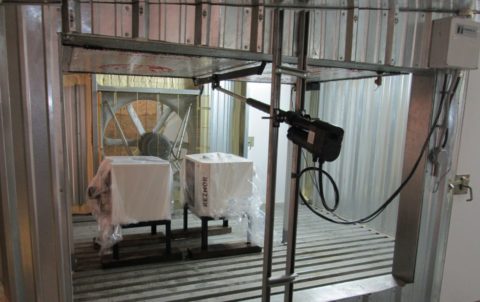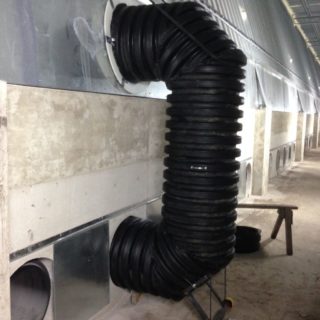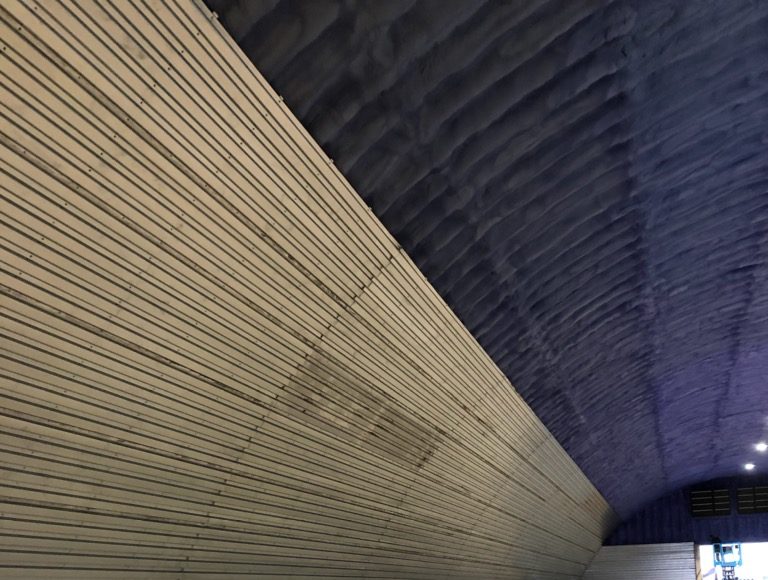[deck]New products, technologies, and ways of thinking about storing your crop — three experts discuss what’s out there and what’s coming in storage structures, ventilation and sprout control.[/deck]
Maintaining the quality of potatoes through storage is as critical to one’s ultimate returns as is growing a good crop in the first place. Gone are the days of throwing a crop into any empty structure and hoping for the best: today’s potato storages offer impressively high-tech options, and more storage management innovation is on the horizon.
The thermodynamic air envelope — more simply known as heated walls — is a mainstreaming storage technology that has grown in popularity as potato storage capacity has increased.
“The fact that some growers are storing far more hundredweight than they used to means that buildings are bigger and piles are harder to watch. You want to hedge your bets by putting in as many upgrades as possible,” says Chad Kleisinger, business development and product manager at Meridian Manufacturing Inc.
“If you put bad potatoes into a building or you don’t cool them right, it doesn’t matter how good your technology is. But, in normal conditions, heated walls certainly maximize your chances of keeping spuds at their best, longer.”
Designed to maintain temperature and control condensation, heated walls consist of a heating and fan system that forces warm air through a four- to six-inch insulated air envelope sheathed in cladding. Heated wall technology was patented in 1994 by Hansen-Rice Inc. After the patent expired in 2011, many companies began applying similar technology, mostly to rigid frame buildings.
In addition to controlling condensation, heated walls offer several side benefits. The air gap offers some insulation value, reducing the total amount of spray foam or rigid insulation required (not enough to compensate for the higher cost of construction, but valuable nonetheless). And, the interior cladding keeps tubers away from exposed foam, reducing dockage, supporting food safety and increasing growers’ likelihood of capturing processing premiums.
That said, heated walls do carry certain downsides. First, when interior cladding is installed over ungalvanized steel trusses (as was typically done until recently), condensation inside the envelope can cause structure-threatening corrosion.
“The issue of rust is a big one,” says Kleisinger. “Because there’s warm air running through and because you’re not seeing condensation on the ceiling above the pile, people thought it was all dry. But then a couple of guys put their forklift forks through the wall by accident and all they could see was rust. The condensation was hidden right inside the envelope.”
In response, today’s companies are exclusively installing galvanized steel. Meridian Manufacturing, which is currently installing envelopes into its arch-walled buildings for the first time, is taking it a step further. To counter rusting from condensation and to manage cost, the air envelope will be an open system that only covers about two thirds of the way up each wall.
The second challenge to heated walls is the upfront investment: expect a 10 to 15 per cent uptick in cost on a conventional steel frame building, and an increase of approximately 5 per cent in Meridian’s arch-wall design.
“We’re not completing the whole arch because we get the same benefits at significantly less cost, and we can recycle the heated air right into the storage, which is much more efficient,” says Kleisinger.
New Way of Thinking
Heated walls are just the start of recent ventilation improvements. Todd Forbush, vice-president and storage systems engineer with Techmark Inc., says many of today’s newest ventilation innovations are arising from a whole new way of thinking about stored crop management.
“One of the things we focus on is not just running a ventilation system, but why the ventilation is running,” says Forbush. “If potatoes were rocks, you wouldn’t need ventilation. The reason you need ventilation is because potatoes are living, breathing entities.”

Tubers’ respiration rates relate to their comfort: stress them and their respiration rate will increase; keep them in an environment where they can remain stress-free and dormant and their respiration will drop. The lower the respiration rate of a stored crop, the lower its ventilation needs.
“What we’re going for now in ventilation is optimizing rather than maximizing,” Forbush says. “What growers tend to still do too much today is err on the side of caution. We offset our lack of understanding about what’s really going on with the stored crop by adding more energy to the system. Rather than saying we’re going to run our fans 24 hours each day because we’ve always run our fans 24 hours each day, what we need to do is investigate the specific stored crop’s needs and then meet those needs through optimized, prescriptive ventilation.”
The first step to optimizing ventilation is understanding that every potato crop stores differently. Countless factors — crop condition at harvest, temperature going into storage, dockage in the pile, building design, ventilation capacity, and so much more — influence how a crop proceeds into and out of dormancy.

“Every potato crop is unique. As an industry, we have to fully embrace that and manage each stored crop as individual,” says Forbush.
Today’s highly sensitive ventilation monitors, usually equipped to transmit data right to a smart device, are excellent interpreters of what’s happening inside a stored crop.
“The potatoes are trying to talk: we’re now doing a better job of trying to listen through watching key performance indicators,” says Forbush.
Though few growers currently manage their storage with an eye to optimization, the monitoring and gauge technology is already in place to facilitate this shift in storage management.
Also available is the technology to manage and direct ventilation. Trademarked by Techmark in 2013 and now capturing commercial uptake, prescriptive ventilation is a disease management system that directs high volumes of dry air via a secondary ventilation system to specific zones of a pile.
“Anytime you deal with storage, you deal with the pathogen triangle: if you have a pathogen, a food source, and the right environment, disease will develop. Pathogens’ existence and the food source are givens. What we want to control is the environment. Prescriptive air removes the environment that supports the pathogen. It’s not just adding extra air, it’s controlling that air,” says Forbush.
Innovations in potato storage technology also include certain new products designed to extend tubers’ storability, enhance quality, or decrease pathogens.
Sprout Control
Burn options designed to rescue a sprouting crop are very new to the market, especially in Canada. 1,4Zap by 1,4Group was introduced to the U.S. market two years ago; SmartBlock by AMVAC has been available to U.S. growers for four years; and clove oil, approved for use in organic production in the United States only, has been on the U.S. market for about 12 years.
In Canada, 1,4Zap has just received technical registration and should be available to producers for the upcoming storage season. Clove oil is less likely to come to Canada anytime soon: currently, no registrations have been filed with the Pest Management Regulatory Agency.
“I don’t think all Canadian growers, especially table stock growers, are aware that they have an option to burn sprouting off with some of these agents,” says Bill Orr, Canada technical representative with 1,4Group. “Processors can handle some sprouting, but as a grower, you don’t want any sprouting because that’s money coming straight out of your potatoes.”
Some companies continue to work on reviving ethylene as a sprout control agent, an effort that has been underway for more than two decades. While ethylene is effective at managing sprouting when it is applied, the product’s primary downside is treated potatoes sprout extremely quickly after removal from storage. Also, chippers and processors do not like ethylene because it throws off potatoes’ colour.
Peracetic or peroxyacetic acid (PAA), a combination of hydrogen peroxide and acetic acid, is a disinfectant and anti-microbial that is highly effective in stopping pathogens and dry rot. Though not new to the market, the product is new to many growers, especially in Canada where uptake is currently low.
“It wasn’t launched well when it was first launched in some regions, so the product is fighting a less than great reputation,” says Orr. “There’s no question it works: I’ve seen some rot issues dried up like I’ve never seen before in my life.”
PAA is multi-purpose — it can be used to disinfect equipment, bulk storages or wooden crates, and can be applied directly to tubers themselves. It is also acceptable for use in organic production.
Despite all kinds of recent innovation in storage products and technology, Orr says the very best monitoring and management technology has never changed and doesn’t cost a dime.
“Use your eyes and your nose. It all comes down to watching your pile. A good storage manager stays up to date with storage innovations but knows there’s no replacement for careful monitoring and hands-on management.”











